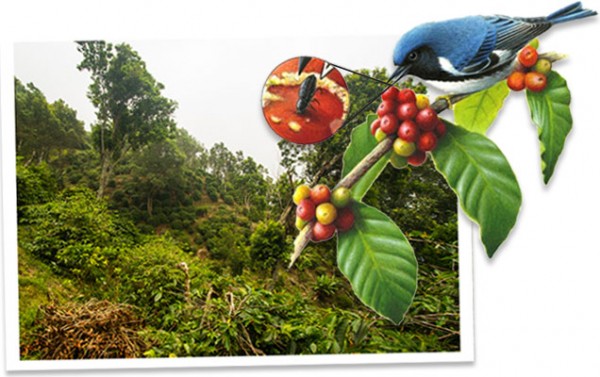PNAS:多一棵树多一份咖啡

在咖啡种植园引入树木能提高咖啡豆产量。
你能否想象一棵树与你的咖啡混在一起?这听上去或许不是个好主意,但一项新研究显示,树木与咖啡灌木混合生长能增加鸟类数量,同时也能提高咖啡产量。
豆类种植者面临的主要风险之一是咖啡果小蠹,这种昆虫会钻孔进入咖啡豆然后把卵产入其中。近日,在牙买加“高山”咖啡农场进行的研究表明,将吃昆虫的鸣鸟引入种植园,能够抑制害虫,例如黑喉蓝林莺(如图所示,一只黑喉蓝林莺正要抓住一只咖啡果小蠹)。
但是,在种植园内维持鸟类种群数量是一项艰巨任务。因为咖啡果小蠹体型很小,并且存在季节性种群变化,它们仅构成鸣鸟食物的10%。为了验证以树木和灌木的形式添加额外的鸟类栖息地是否能带来不同,生物学家创造了咖啡农场内部及周边生态系统的一系列计算机模拟程序。
结果显示,将大约5%的咖啡种植面积替换为树木,并将树木随意分散在农场里,能使生活在这里的鸟类数量增加3倍。4月7日,研究小组将相关成果在线发表于美国《国家科学院院刊》。
这些增长能将咖啡果小蠹的感染率从大约35%降低至15%以下,而且尽管咖啡种植面积减少,却仍带来了咖啡豆产量的轻微增加。假如该模拟结果能用于现实世界,或许让你的咖啡伴着少许灌木可能是一个好选择。
原文摘要:
Effects of land use on bird populations and pest control services on coffee farms
Steven F. Railsback and Matthew D. Johnson
global increases in both agriculture and biodiversity awareness raise a key question: Should cropland and biodiversity habitat be separated, or integrated in mixed land uses? Ecosystem services by wildLife make this question more complex. For example, birds benefit agriculture by preying on pest insects, but other habitat is needed to maintain the birds. Resulting land use questions include what areas and arrangements of habitat support sufficient birds to control pests, whether this pest control offsets the reduced cropland, and the comparative benefits of “land sharing” (i.e., mixed cropland and habitat) vs. “land sparing” (i.e., separate areas of intensive agriculture and habitat). Such questions are difficult to answer using field studies alone, so we use a simulation model of Jamaican coffee farms, where songbirds suppress the coffee berry borer (CBB). Simulated birds select habitat and prey in five habitat types: intact forest, trees (including forest fragments), shade coffee, sun coffee, and unsuitable habitat. The trees habitat type appears to be especially important, providing efficient foraging and roosting sites near coffee plots. Small areas of trees (but not forest alone) could support a sufficient number of birds to suppress CBB in sun coffee; the degree to which trees are dispersed within coffee had little effect. In simulations without trees, shade coffee supported sufficient birds to offset its lower yield. High areas of both trees and shade coffee reduced pest control because CBB was less often profitable prey. Because of the pest control service provided by birds, land sharing was predicted to be more beneficial than land sparing in this system.
标签: 树木 咖啡
作者:唐凤

